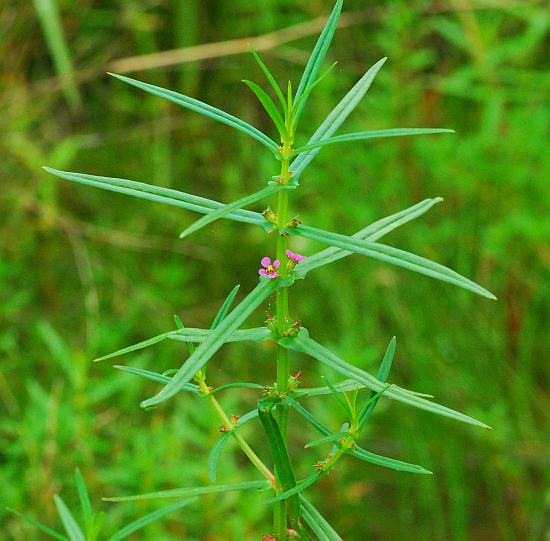Ammannia coccinea Rottb.
Toothcup

Native
CC = 6
CW = -5
MOC = 65
© SRTurner
Ammannia coccinea Rottb.Toothcup | |
 |
Native CC = 6 CW = -5 MOC = 65 |
© SRTurner |
|
Family - Lythraceae Habit - Annual fibrous-rooted forbs, terrestrial or strongly emergent aquatics. Stems - Ascending to erect, to 50 cm, square in cross section, glabrous, sometimes branched, sometimes rooting at lower nodes.
Leaves - Opposite, simple, linear, sessile, auriculate-cordate at base, sharply pointed, glabrous. Leaf arrangement strongly decussate. Leaf undersides with single prominent midrib.
Inflorescences - Axillary clusters of 3-5 flowers, usually with a stalk to 5 mm long.
Flowers - Actinomorphic, usually on short stalks. Sepals 4. Hypanthium plus sepals 2.5-4.0 mm long. Petals 4, 1.5-2.3 mm long, deep pink to purple. Stamens 4, the anthers deep yellow. Style exserted.
Fruits - Globose to capsules, 3.5-5.0 mm diameter, dehiscing irregularly with age, the outer wall smooth. Seeds numerous, 0.7-1.0 mm long, asymmetrically ovoid, the surface with a network of fine ridges, brown.
Flowering - June - October. Habitat - Pond margins, mud flats, slow streams, ditches, railroad swales. Origin - Native to the U.S. and tropical America. Other info. - This attractive little species can be found throughout most of Missouri, as well as most of the southern half of the U.S. It can be identified by its narrow, opposite leaves with basal lobes and deep pink flowers. Another species, A. robusta, looks similar but has paler flowers and flower clusters which are sessile. A third species, Rotala ramosior, also looks similar but has leaves which taper to the stem and lack the basal lobes. Of the three, A. coccinea is the most common in Missouri, though mixed populations can be found, since the three colonize the same habitats. Look for them in open areas of mud exposed by receding water levels. Under favorable conditions they can form large populations. Photographs taken near Angel Mounds, Evansville, IN., 8-5-06 (DETenaglia); also at Pacific Palisades Conservation Area, MO, 7-31-2010, Onondaga Cave State Park, Crawford County, MO, 8-25-2014, and Riverfront Park, Washington, Franklin County, MO, 9-20-2019 (SRTurner). |